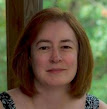On our UK trip last week, we ended up staying one night in the market town of Chesterfield in Derbyshire only by happenstance. I'd looked on a map and noticed it was close to Hardwick Hall, which I wanted to visit, so I made a reservation at an inn close by the town center. Off we went.
While we were walking around the shops of downtown Chesterfield on our way back from dinner, Mark noticed something unusual in the distance. "Isn't that spire crooked?" he asked me. I agreed, and we both looked at the oddly twisted spire for a minute, the image jogging my memory slightly. Then I opened my Kindle on the flight home to Chicago and remembered why it was familiar. It seems I had bought Chris Nickson's new medieval mystery a few months ago, and what do you know. There was that spire again.
Of course I had to read the book right then and there.
The Crooked Spire opens in the year 1360 as John, a talented carpenter, arrives in Chesterfield looking for work. He comes with experience – he'd previously worked on York's famous Minster – so, after some tests of his abilities with wood, he gets taken on as part of a team of craftsmen who'll be reinforcing the ceiling of St. Mary's church before installing the tall, heavy spire.
But after he discovers a corpse on the floor of the church tower early one morning, the coroner eyes John with suspicion. It's risky to be a stranger in town when murder is afoot. John isn't without friends, though. They include a young boy, Walter, who takes to him as a father figure of sorts; Walter's pretty older sister, Katherine; and the kindly Widow Martha, who offers John a place to stay in her lodging house on Walter's recommendation.
The novel offers a fully-formed picture of English medieval life as seen from the viewpoint of ordinary people; there are no royals in sight here. Nickson's scene-setting and character development are both well done. I liked spending time with John as he walked along Chesterfield's bustling streets after a hard but rewarding day of labor and as he dined on his landlady's delicately spiced meals at her home on Knifesmithgate (a street I remember seeing on my own travels).
All the while, I was introduced to legal matters of the era and the ins and outs of church architecture. For example, as the one who found the body, John has to pay the coroner a fee, which hardly seems fair. That's bureaucracy for you. But despite the dangers John faces, there's an underlying acknowledgment that he and other folks are the lucky ones. The Black Death is only twelve years past, and the pestilence had killed John's own parents and an abundance of others. If the townspeople seek out what enjoyment they can in life, who can blame them?
The body count rises as the plot proceeds, since the original murder isn't an isolated incident at all. John impresses the coroner with his quick mind, something unexpected in an ordinary laborer. His investigative techniques are logical, if not always terribly sophisticated. To find one probable murderer, he and Walter look for a man wearing bloodstained clothing – but that does get the job done. John's admirable pursuit of the truth not only leads him to reevaluate his life but turns up a tightly woven web of corruption. It all concludes on a satisfying note.
And for those like me who wondered how the crooked spire of the title might have come to be... there are explanations in that regard, too.
The novel left me wishing I'd seen more of Chesterfield in person, but since this is the first book in a planned series, I'll definitely be back to spend more time there.
The Crooked Spire was published in late 2013 by The Mystery Press at £8.99/$13.95 in paperback (264pp) or you can do as I did and snag it for $3.79 as a Kindle book.
▼
About Me

- Sarah Johnson
- Collection management librarian, readers' advisor, avid historical fiction reader, NBCC member. Book review editor for the Historical Novels Review and Booklist reviewer. Recipient of ALA's Louis Shores Award for book reviewing (2012). Blogging since 2006.


This sounds exactly like the sort of thing I like. :)
ReplyDeleteLove, C,
It's an unpretentious, solid read. There should be more like it!
DeleteThe local story is that the spire will straighten if a virgin ever gets married in the church!!
ReplyDeleteHa! Love it :)
Delete